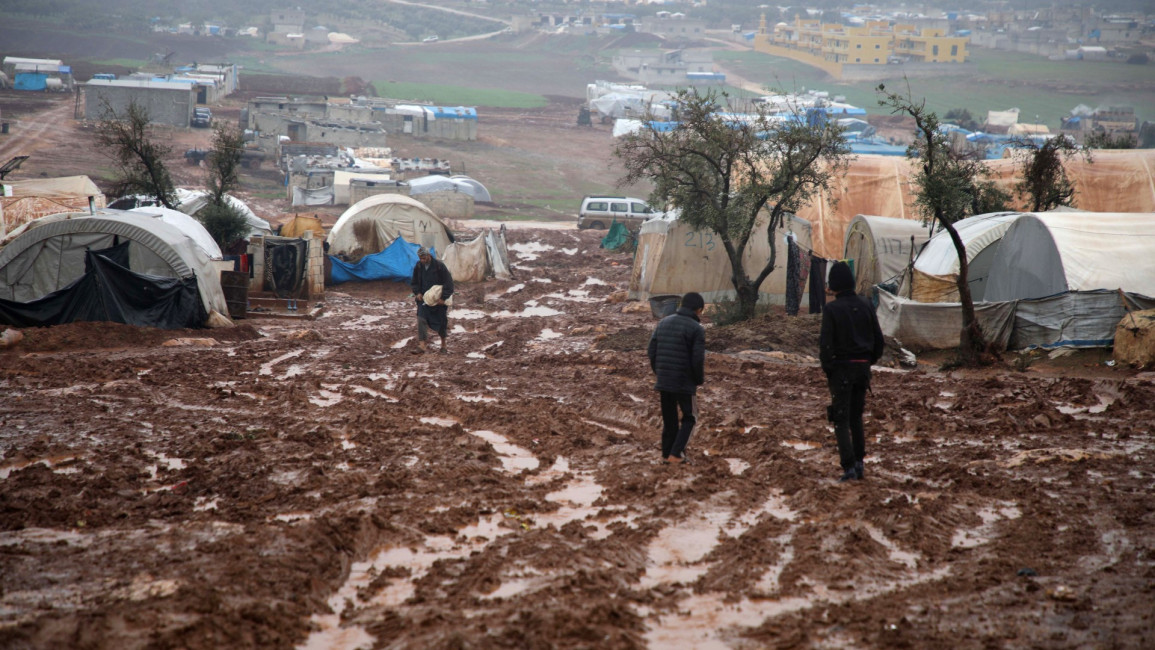Syrian regime 'targeted IDP camps' with cluster bombs and missiles, report finds
Makeshift camps for internally displaced persons (IDP) in Syria were intentionally targeted by regime missiles, cluster bombs, and other deadly munitions, a new report has found.
The Syria Justice and Accountability Centre (SJAC) recorded a number of attacks between 2014 and 2022 by the Syrian regime and its allies, with displaced Syrians living in tents having no protection to the deadly bombardments.
The report found that intelligence gathering by regime forces prior to the attacks showed that aircrew were likely aware that civilians were housed in the camps, including those in Idlib province which had already struggled with flooding, a lack of medical facilities, and limited food and clean water.
Starting from an archive of 2 million videos, the SJAC verified 17 incidents of attacks on camps, which could easily be identified as civilian in nature from the air due to their "distinctive layouts and characteristic, blue-colored tents", the report stated.
Witnesses reported regime or allied aircraft circling their camp several times before dropping their payloads with the Al-Naqeer camp in Idlib being repeatedly targeted despite overwhelming evidence it hosted IDPs.
Bombings of camps in the area were so frequent that residents had resorted to digging pits in the ground to serve as rudimentary air raid shelters.
In 2014, regime aircraft circled the camp forcing residents to head for the pit or wait in their unprotected tents for the bombs to rain down.
"We were watching the helicopter heading straight towards the camp, and while it was over the camp, it dropped a barrel bomb on the camp, and we saw it first-hand. The place where the barrel fell was on the outskirts of the camp. As usual, the helicopter returned to drop the second barrel, which fell right in the middle of the camp," a witness said.
"The people residing in the camp started screaming over the scattered bodies that were in shreds and pieces due to the barrel bomb, all the tents were torn apart by pressure as if they never existed there. The civil defense and civilian cars came to aid the wounded and bury the dead."
Another attack on a nearby camp saw 18 residents killed when it was targeted by two barrel bombs although the SJAC could not confirm casualty figures caused by any of the attacks on the IDP camps.
It did say that barrel, parachute, and volumetric bombs were used in attacks on IDP camps, along with ballistic missiles and cluster bombs, a weapon designed for use against armour and infantry.
Residents were often sitting ducks when the regime and allied aircraft struck with nothing more than the canvas lining their tents for protection.
An open-source investigator at SJAC that there was no logical reason why these camps were targeted but they contributed to the mass exodus of Syrians toward the Turkish border during regime offensives in Idlib and Aleppo.
"What made these attacks so unconscionable was the fact that these camps are located in areas far away from the military frontlines and full of civilians, women and children," the researcher told The New Arab.
"Politically, bombing IDP camps pushes civilians to flee the country towards safer countries, such as Turkey. In our investigation, we found many camps located a few kilometers away from Turkish borders. By bombing these camps, the Syrian government was able to 'punish' their regional adversaries by flooding their borders with Syrians escaping violence."
Many in the camps were IDPs who had fled opposition areas elsewhere in Syria when they fell to the regime and the targeting of camps in Idlib could be seen as a form of collective punishment.
"The evidence we found as investigators indicated that the Syrian government and its allies wanted to put pressure on the opposition," the investigator added.
"Most of the aforementioned IPDs refused to live under Syrian government rule, and the attacks came in the form of collective punishment for those who chose the other side... based on the evidence related to the weapons that were used and considering the nature of the targeted areas/camps, it is obvious that the attacks were executed in order to kill as many people as possible."
The evidence gathered by the SJAC has been stored on a database for possible legal action in the future, although the investigator admitted that the avenues for prosecution of suspected commanders who ordered the attacks is at present limited.
"We hope that these investigations show the public and policymakers that Syria is not safe and refugees who are forced to return to the country will face real threats to their lives,"
"Even if there is no legal outlet to address these crimes, the international community must maintain pressure on the Assad government and avoid normalizing relations until concrete changes are made to ensure the safety of the Syrian people."



